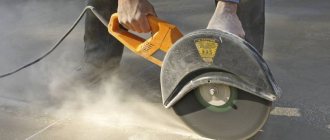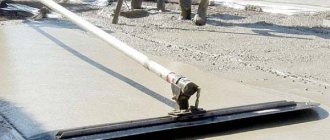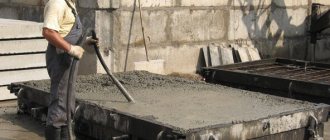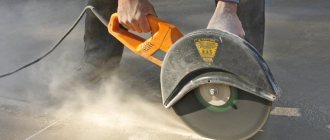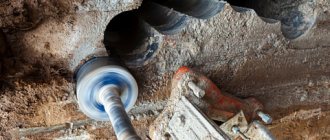Concrete structures have to be destroyed during the demolition of buildings and structures recognized as unsafe. There are situations when reinforced concrete panels delivered to the site need modification; holes are sawed through them, individual fragments are cut off, or holes are drilled for installation of electrical wiring (laying heating pipelines, wiring hot and cold water supply pipes, as well as for sewage systems). Similar work can be performed using special tools and machines similar to equipment for diamond cutting of concrete. They are distinguished by high hardness, comparable to diamond. Reducing the harmful effects on humans and the environment is achieved by using aqueous solutions; operators use personal protective equipment.
What is diamond cutting of concrete
Cutting reinforced concrete structures using carbide or diamond tools is characterized by a number of indicators:
- the cutting process occurs in a limited area. The concrete product itself is subject to a directed action without heavy impacts. Therefore, long cracks do not form. There is no dangerous propagation of the impact load throughout the building or adjacent rooms;
- The noise level is low. People around perceive only the vibration that occurs when pebbles or other solid inclusions hit;
- The use of dust collectors allows you to carry out work inside apartments. Reinforced concrete sawing products are removed using an aspiration system. Dust and sand are discharged into bags or dust collectors;
- the speed of cutting panels depends on the type of technological equipment used, as well as the condition of the cutting edges of the tool used;
- You can start cutting hard material without lengthy preparation. It is necessary to fix the supports, and then direct the cutting part in the desired direction;
- carbide edges on the teeth help to obtain smooth walls. The feed (moving the tool per revolution of the disk or bit) is low, so the distance between the marks is measured in fractions of a millimeter. A polished surface is formed;
- The processing tool uses carbide tips. Their hardness reaches up to HRC 70...80 units, only diamond is harder (HRC 100). Building materials have significantly lower strength indicators; all types of products are processed;
- the presence of enclosing casings and catchers prevents the danger from flying fragments formed when sawing concrete;
- technological equipment is equipped with fairly powerful electric motors (energy-rich tools). Limited space is no problem even when used in short and narrow spaces.
For difficult situations, additional attachments are provided; they help change the direction of cutting.
Application area
If it is necessary to reconstruct industrial or public buildings, to organize passages or openings between rooms, or to install complex technological equipment (installation of air conditioners, laying power cables, wiring a water supply or sewerage network), diamond cutting is used.
The main tasks solved using special diamond equipment:
- when demolishing emergency buildings or dilapidated housing, it is necessary to cut building structures;
- work on dismantling brick, block walls and structures made of cast concrete cannot be imagined without the use of devices and devices for cutting with carbide tools;
- organizing access to attics, creating empty space between floors when it is necessary to build flights of stairs, completely remodeling buildings for a new purpose forces a complete restructuring of the internal space;
- removal of defects resulting from errors and defects in concrete casting. It is easier to cut fresh concrete immediately after removing the formwork or façade putty than to cut it out later with jackhammers or hammer drills with certain types of attachments;
- adjustment of the foundation, load-bearing beams and columns, as well as processing of reinforcement beams;
- when the walls are long, sometimes it becomes necessary to create expansion joints; they help compensate for the movement of wall structures during sudden temperature changes;
- carrying out work in damp areas;
- dismantling of industrial buildings when clearing areas for new construction or use for a new purpose;
- high-altitude work where dismantling has to be done using lifts.
Drilling is used when changing the size of openings in the case of reconstruction of premises, replacing windows and doors.
Cutting and drilling of wall structures using diamond devices is carried out:
- creation of openings and passages in load-bearing walls, as well as light partitions. If necessary, you can specify non-standard sizes and complex configurations;
- dismantling partitions between rooms by first changing and reducing the size of wall fragments;
- correction of defects that arose due to violation of the technology of casting concrete mixture into formwork;
- creation of channels for laying utility networks inside and outside the building;
- changing the size of individual rooms, dismantling auxiliary accessories and other similar work.
Advantages and disadvantages
Builders note positive indicators:
- dismantling work is organized in a short time;
- there is no need to carry out lengthy preparation, you need to coordinate between the customer and the main contractor, as well as obtain permission from architectural departments and agree on the reconstruction project;
- the equipment is placed in the cabin or trunk of a car and can be easily carried by one or two workers;
- destruction products are carried outside the main process;
- productivity is extremely high, the production process can be carried out in several shifts. Particularly important when performing emergency work;
- the cost of the procedures is much lower than using jackhammers and rotary hammers.
The disadvantages of diamond-based drilling rigs do not reduce the efficiency of work using diamond tools, but they are also worth noting:
- the cost of the tool itself is high, so only workers who have gained the necessary experience in using complex equipment are allowed to work;
- In the process of carrying out operations for cutting concrete fences, it is necessary to change the cutting tool in order to bring the worn one back to normal: replace the cutting elements or sharpen them. Working with blunt teeth requires increased energy consumption and reduces labor productivity.
To remove destruction products, it is necessary to organize emission zones. There may be a lot of dust around. Coordination with the relevant authorities is required to pay taxes for environmental pollution.
Types of tools and equipment
Diamond cutting is a direction that began its development relatively recently. Methods for cutting stone products and concrete are being updated. Therefore, the emergence of new types of structures based on the use of hard alloys and the spraying of diamond chips on cutting edges is possible. How putty differs from putty read here.
Rope systems
The advantage of this design is the cooling effect of the abrasive after leaving the cutting limits. Cooling air is supplied to the free branch of the rope system (fans are used). As a result, the cutting edges do not overheat.
To complete the job, it is sometimes necessary to drill holes through which the branches of the rope will be pulled. Therefore, in confined spaces it is necessary to use auxiliary drilling equipment.
When producing a work cycle in open areas, such a tool shows high productivity. It can be mounted with small tractors and similar mobile equipment. Hydraulic control helps in the operation of the manipulator.
For work, a special abrasive rope is used. It is pulled between rollers located at a certain distance.
Diamond chainsaws or chains
Gasoline and electric chain saws can be used as a drive device. Instead of a regular chain, a chain is installed on the tool, in which instead of teeth there are abrasive elements. Applied in a thin layer to the work surface, they can grind down stone or concrete that gets into the contact zone. Find out how many bricks are in 1m3 here.
Using blades more than 700 mm long, experienced workers make cuts in foundations more than 550...600 mm thick. The use of gas-powered tools allows you to carry out emergency and rescue work in places with high humidity. This tool is included in the standard kit of mountain rescuers. It is used in tunnels for making passages in rock.
Renovators with diamond tips
Small-sized tools (renovators) began to spread among craftsmen relatively recently. In them, the rotation of the electric motor rotor is converted into reciprocating motion. An abrasive is mounted on the moving part, which processes the parts. Read about a kitchen apron made of MDF with 3D photo printing in this article.
The industry produces renovators with batteries, as well as network devices. The cordless tool allows you to work regardless of the power source. They are used not only inside buildings. Working at height, craftsmen can perform complex tasks without paying attention to outside nutrition.
Network renovators have more power. They are usually equipped with nozzles of different configurations. Therefore, the quality of work using such devices and the subsequent finishing of walls with MDF panels does not cause any complaints from customers.
Small dremels are a type of hand-held power tool. For processing concrete surfaces, they are equipped with various types of diamond cutters.
Using a Dremel, an experienced craftsman can shape a door or window opening so that no additional installation of a metal or wood frame is required. The joining of the sashes will be perfect in any place. This is how original passage systems are created in rocks.
Disk devices are mounted in angle grinders or electric saws. Diamond coated discs are used. In the presence of industrial-type vacuum cleaners, a dust cloud does not form in the work area. All dust settles in bags or cyclones are used, in which the swirling flow independently gets rid of heavy inclusions. This article will tell you about the sizes of red facing bricks.
Stationary disc machines for cutting concrete and tiles are equipped with coolant supply systems. This way the cut is smooth, and the destruction products are diverted outside the working area with water.
Tips from the experts
The photo shows the cutting of a concrete base for further planning
Cutting concrete is, although a fairly simple procedure (especially in comparison with forming it), but still has a lot of nuances:
- When cutting dry, it is recommended not to make too long cuts. Try to work with intermittent movements. It is recommended not to make a cut lasting more than 1.5 - 2 minutes
- To cut without dust with an angle grinder, you need to use water. If the water supply is located within your reach, then take a small diameter hose and attach it to the grinder. Water should continuously wet the disc. If there is no running water, get an assistant. It should water not only the disc, but also the seam. Many people use large syringes, which are used to change the oil in a car. The helper must carefully monitor your actions so as not to flood the equipment.
- Wet cutting is not recommended for renovation work in apartments, as it can flood those neighbors who are located on the floor below.
- Before carrying out work, you need to worry about the availability of 3-phase electricity. This equipment consumes quite a large amount of electricity.
Main recommendation. Masters do not advise beginners in this business to carry out the work themselves, who simply due to inexperience may not take into account all the subtleties that arise in a particular situation.
Thanks to the use of various techniques, work can be done even in cramped circumstances. Low noise and dust levels make equipment for diamond cutting of concrete indispensable when carrying out repairs in apartments.
In private properties, diamond cutting of concrete will become a real assistant. For a person far from construction, this procedure is rare, but, nevertheless, in some cases it is simply irreplaceable. Therefore, it is better to be prepared for it than to remain in blissful ignorance - “until the cancer hangs on the mountain.”
DIY technology for drilling holes in concrete
To drill concrete, unlike fireclay bricks, hammer drills and drilling machines are used. The process itself is carried out with drills, drills and crowns.
The presence of a thin layer of diamond chips on the surface allows for highly productive penetration.
It should be remembered that heat removal during drilling is difficult. Therefore, cooling is needed. Experienced craftsmen remove the tool from the hole and allow it to cool.
On drills, crowns and concrete drills, the cutting edges are soldered using bronze (melting point 870...920 °C). If you do not cool it, the solder will melt and the carbide tip will fly out. The tool will become unusable.
How to choose diamond-coated drills
When choosing a tool for certain work, we focus on:
- Availability of the necessary tools to install the drill. If you have a hammer drill, then purchase drills with a special tip that has a groove. If you only have a conventional drill, buy drills with a cylindrical tip;
- Only a tool of a certain diameter can be installed in the chuck. If the actual diameter exceeds the installation capabilities, then it is not advisable to buy it;
- To work with glass surfaces, you need a tool that can only drill through it. Trying to use other devices will not bring any benefit. For cooling, plasticine is used to create baths into which water or a solution with ammonia is poured. This is how drilling is performed with simultaneous cooling;
- Preference should be given to drills where carbide materials are specified. Preference should be given to those where VK-8 or VK-10 are indicated. They contain tungsten and can withstand shock loads. The presence of the designation T15K6 or T10K15 indicates that it is possible to drill at high rotation speeds. But shock loads are less tolerated.
Drilling process with diamond core bits
A diamond crown allows you to drill not the entire hole, but only the ring. This reduces energy costs for the procedure itself. The crown self-aligns as it moves through the body of the material. The cylindrical part serves as a guide.
To produce deep holes, crowns with an elongated working part are used. Allowed depth is up to 300…350 mm.
Wall marking
Before starting drilling, as when installing perforated MDF panels, mark the wall. Laser devices are used to determine the height and horizontal position.
Using a laser level when marking walls.
The use of special console machines helps to maintain a straight feed. The base of the machine is rigidly fixed to the base. Be sure to control the forces that arise during parallel feeding of the drilling head.
Organize water supply and removal systems. Drainage shells are mounted on the wall, as well as pipelines for draining and cleaning the coolant.
Drilling
Having prepared the equipment, we begin drilling. The depth of penetration of the crown into the body is periodically checked. Sometimes you need to use a chisel to cut off the inside of the hole. Then the process is resumed.
Having reached the required depth, stop the action. They check the depth; sometimes it is necessary to clear the bottom using a hammer drill and a spade-shaped tip.
What obstacles can you encounter?
When drilling, you need to accurately determine the location of the electrical wiring. It is especially important to treat such actions in residential buildings.
During different periods of construction, different methods were used to organize grooves for electrical wiring in the walls.
Oblique (diagonal) placement of the groove was especially often used when using French technologies for the manufacture of concrete panels. Similar buildings were built from the late fifties to the mid-sixties of the last century.
An obstacle may arise in the form of reinforcement located at the drilling site. The decision is made by the customer (his representative) and the responsible executive. Changes to the project are possible only with the agreement of both parties.
Safety precautions
Several basic labor safety rules must be observed when drilling holes in concrete structures. What is the correct name for bleaching bleach and what is it used for, read in this material.
In some cases, on-the-job training is provided. Based on its results, workers leave a signature in the occupational safety journal.
Some of the safety requirements are specified in the instructions for using power tools. There are also general recommendations; the responsible executive must familiarize his subordinates with them.
Life story
I have a neighbor in Jurmala, he lives not far from me on the banks of the Lielupe River. In addition to the sea, we also have a river. He built himself a house in the 2000s. These were not yet very strict times in matters of compliance with building standards, and his architect made a mistake.
I was wrong, in a word. By law, the consent of the owner of the neighboring plot is required if a permanent structure approaches more than 3 m to the border of the neighboring plot. This standard was not observed and was 1 meter closer than the three-meter zone.
I tried to agree on the fact and give permission retroactively. But the neighbor ran into nothing. So we had to saw off part of this house to get into the standard. They sawed off walls, ceilings, an underground garage, and a garage floor. These works cost a tidy sum. Yes, so that there are no misunderstandings, both were Russian-speaking.
Conclusion
- Diamond cutting facilitates work during the reconstruction of buildings and the need to demolish emergency and dilapidated buildings.
- Diamond and carbide tools allow you to work without unnecessary noise and perform actions with minimal emissions of dust and contaminants. An aspiration system equipped with vacuum cleaners and sedimentation cyclones helps.
- They use rope-type devices, chains coated with hard alloys and diamond substitutes, and discs.
- Air and water cooling are used to cool cutting edges.
- Drills, crowns and drills are used for drilling brick and concrete, but the amount of heat needed to heat the brick must be taken into account. They use hand-held power tools and stationary portable machines.
- When carrying out work, safety regulations must be observed.
